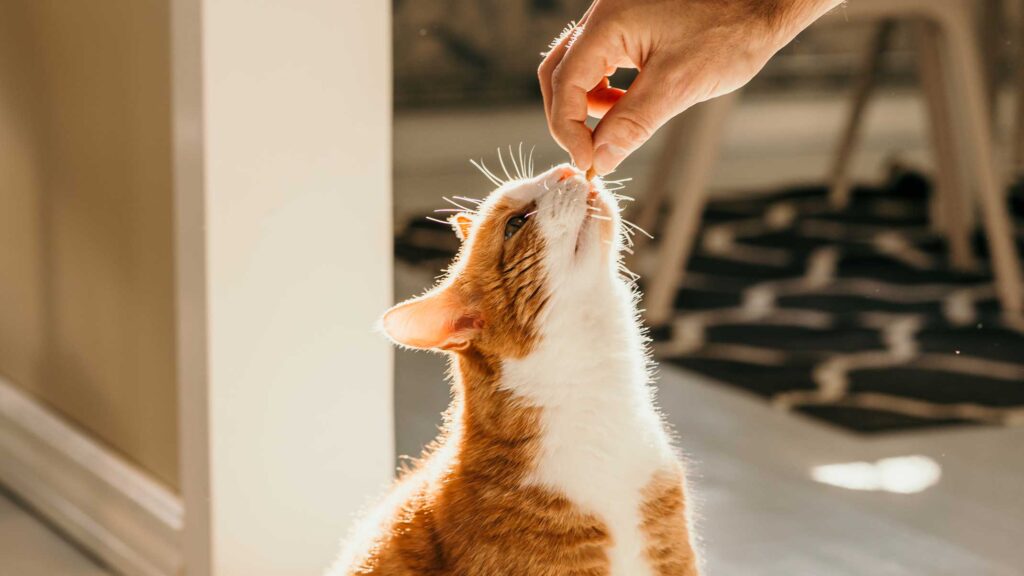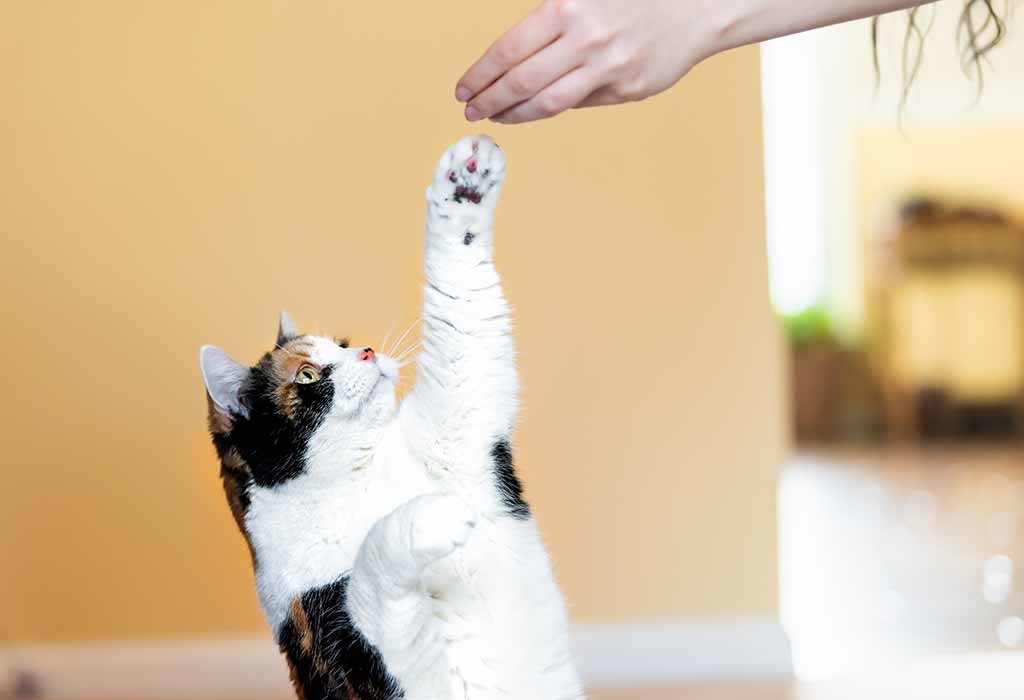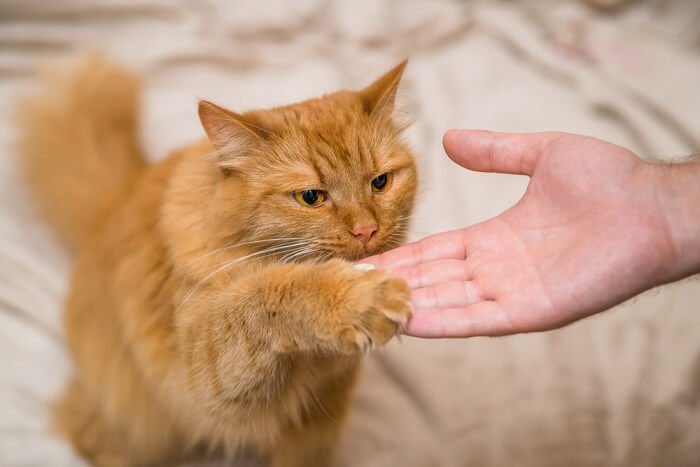How to Train Your Cat Without Treats

Training your cat can be a rewarding experience that strengthens your bond with your pet cat. While treats are a popular choice for training, they may not always be the best option. Perhaps your cat has dietary restrictions or simply doesn’t respond well to food-based rewards. Fortunately, there are many other methods to train your cat without treats effectively.
Benefits of Training Your Cat Without Treats
The benefits of training your cat are numerous. Training can help to prevent problem behaviors, such as scratching furniture or biting. It can also encourage positive behaviors, such as using the litter box, playing with toys, or coming when called. Training can even improve your cat’s health, as it can encourage exercise and mental stimulation.
While treats are often used as rewards for good behavior during training, some cats may not be motivated by food. This could be due to dietary restrictions or a simple lack of interest. Additionally, some cats may become overweight or develop other health issues if they receive too many treats. Fortunately, there are many other options for training your cat.
Training without treats can be challenging, as it may take longer to see results. However, the rewards of a well-trained cat are well worth the effort. By using alternative methods such as playtime and praise, you can train your cat effectively while also promoting good health and behavior.

Here are some of the ways you can train your cat without treats:
1- Positive Reinforcement
Positive reinforcement is a training technique that rewards desired behavior with praise, attention, or play. This method encourages your cat to repeat the behavior in the future. When using positive reinforcement, it’s important to reward your cat immediately after the desired behavior occurs. This helps your cat understand what they did right.
For example, if you want your cat to use their scratching post instead of your furniture, reward them with praise or playtime when they use the post. Over time, your cat will associate using the post with positive outcomes, and it will become a habit.
Another way to use positive reinforcement is to provide your cat with access to something they want after they have performed a desired behavior. For example, if your cat enjoys sitting on the windowsill, you can reward them for using their scratching post by allowing them to sit on the windowsill for a few minutes afterwards. This can be a powerful motivator for cats and can help them learn new behaviors quickly.
Additionally, using a consistent and predictable routine can also reinforce positive behavior in cats. If your cat knows what to expect from their daily routine, they may be more likely to repeat desirable behaviors, such as using the litter box or scratching post. Consistency and predictability can help cats feel more secure and comfortable in their environment, which can lead to better behavior.
2- Clicker Training
Clicker training is a form of positive reinforcement that uses a clicking sound to signal to your cat that they have performed the desired behavior. To begin clicker training, you’ll need a clicker, which you can find at most pet stores, and a small treat. Click the clicker and then immediately give your cat a treat. Repeat this process several times, until your cat associates the sound of the clicker with receiving a treat.
Once your cat understands the association between the clicker and the treat, you can begin using the clicker to train specific behaviors. For example, if you want your cat to sit, click the clicker when they sit down, and then reward them with a treat.
3- Toys and Playtime
Toys and playtime are great ways to train your cat without treats. Cats are natural hunters and enjoy chasing and pouncing on toys. By using toys during training, you can channel your cat’s natural instincts and encourage them to perform desired behaviors.
For example, if you want your cat to come when called, use a toy to get their attention, and then reward them with playtime. Over time, your cat will learn that coming when called results in playtime, and will be more likely to respond to your call.
In addition to using toys during training, incorporating interactive playtime with your cat can also be a form of training. Playtime provides mental and physical stimulation for your cat, and can improve their overall behavior and mood.
Engage your cat in interactive play with toys such as wand toys, laser pointers, or puzzle toys. This can help them learn to focus their attention and energy on specific tasks and can strengthen the bond between you and your cat. Regular playtime can also help prevent destructive behavior such as scratching furniture or other household items.
4- Voice Commands
Voice commands are an effective way to train your cat without treats. Cats are intelligent animals that can learn to recognize specific words and phrases. By using voice commands during training, you can teach your cat to perform desired behaviors.
To begin using voice commands, choose a specific word or phrase for each behavior you want to train. For example, use “sit” for sitting, “come” for coming when called, and “stay” for staying in one place. Use the voice command consistently each time you train, and reward your cat with praise or playtime when they perform the desired behavior.
It’s also a good idea to pair voice commands with hand gestures or body language to make them more effective. For example, you can use a hand gesture to signal your cat to come to you when you say “come.” This will help reinforce the behavior and make it easier for your cat to understand what you want them to do.
5- Verbal Praise
Similar to Voice Commands, verbal praise is a simple but effective way to train a cat without treats. It helps to reinforce positive behavior and build a stronger bond between you and your feline friend. When your cat does something you want them to do, such as using the litter box or scratching on their scratching post instead of your furniture, use a happy, upbeat tone of voice to praise them.
Be consistent with your praise and use specific words or phrases to associate with the desired behavior. For example, saying “good kitty” or “well done” when they use the litter box correctly can help them understand what behavior you are praising.
It’s important to note that cats respond best to praise when it’s immediate. This means that you should praise your cat as soon as they do something right, rather than waiting until later to give them verbal praise. This will help them associate the behavior with the positive reinforcement.
6- Consistency and Patience
Regardless of the training method you choose, consistency and patience are key. Cats learn best through repetition, so it’s important to train regularly and consistently. Keep training sessions short and positive, and be patient with your cat as they learn. Remember to reward desired behaviors immediately and to stay calm and positive throughout the process.
In conclusion, training your cat without treats is not only possible, but it can also be an effective way to strengthen your bond with your feline companion. By using positive reinforcement, clicker training, toys and playtime, voice commands, and patience, you can train your cat to perform desired behaviors and create a happy, healthy home for you and your pet cat.
Common Challenges and Solutions

Training your cat without the use of treats can present some unique challenges, but with patience and persistence, you can still achieve success. Here are some common challenges you may face when training your cat without treats and how to overcome them:
- Lack of Interest: Some cats may simply not be interested in training without treats. To overcome this challenge, try using other forms of positive reinforcement, such as praise, playtime, or affection. For example, you can pet your cat and give them verbal praise when they perform a desired behavior.
- Distractibility: Cats can easily become distracted during training sessions, especially if there are other people or animals in the room. To address this, train your cat in a quiet, distraction-free environment. You can also use a clicker or a specific sound to signal the start of a training session, which can help your cat focus.
- Boredom: Training sessions that are too long or repetitive can quickly become boring for your cat. To prevent this, keep training sessions short and varied. Mix up the behaviors you are training and incorporate playtime or other activities to keep your cat engaged.
- Stubbornness: Some cats may be more stubborn than others, making training without treats a challenge. In these cases, it’s important to be patient and persistent. Use positive reinforcement consistently and don’t give up if progress seems slow.
By understanding these common challenges and their solutions, you can successfully train your cat without the use of treats. Remember to be patient, consistent, and always use positive reinforcement to encourage your cat to learn new behaviors.


